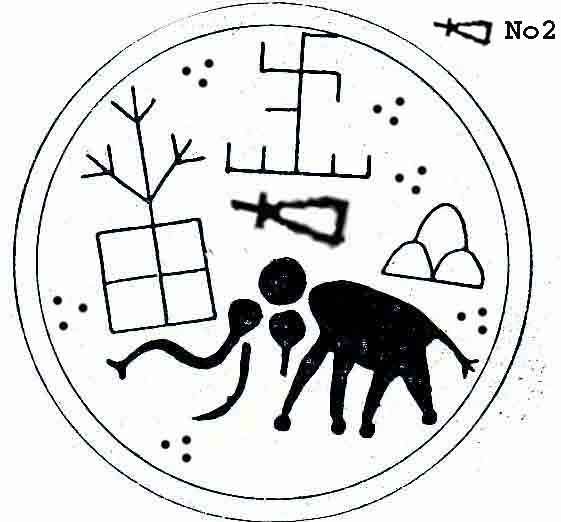Sri Lankan coins: ELEPHANT AND 卍.

「Картинка кликабельна. Coins in the Colombo Museum」
The coins were found during excavation at Salgaswatte Anuradhapura and the strata in which they were found was dated to 300-100 BC, A hoard of these coins were dug up at Tissamaharama, a photo of the broken pot is shown below

8. DEVANAMPIYA TISSA 307-267 BC - second Son of King Mutasiva - His close friendship with Emperor Asoka in India led to the introduction of Buddhism by Mahinda in 247 BC. His sister Sangamitta arrived with the branch of the Bodhi Tree from Buddha Gaya. The tree still exists as the oldest historical tree in the world. She also established the order of the Bhikkuni’s (Nuns).
All ancient Sri Lankan kings were believed to be future Boddhisatavas.There is a popular belief that the statue of a Bodhisatva at Mihintale Hill at Anuradhapura is that of King Devanampiyatissa.

Head of Bodhisatva now known to the people as that of King Devanampiyatissa.

Inscriptions with reference’s to King Devanampiyatissa -identified by Dr S Pranavitane.
1. Mihintale
A donation of Varunadatta- sister of King Devanampiyatissa wife.


This large handsome coin is believed to have issued by King Devanamptiyatissa to Commemorate the propagation of Buddhism in Ancient Sri Lanka by Rev Mahinda. The Railed Swastika on the reverse side of the coin is the Royal Emblem of the first dynasty of kings. This is found on the reverse of all coins of the other kings of that period.
The standard symbol or the Dhajaya found between the Railed Swastika and the Elephant is believed to be the sign symbol of king Devanampiyatissa.

The Elephant

Mr P Weerasinghe in another RAS journal describes the symbol between the Elephant and Railed Swastika , now believed to the standard or Dhaja[ flag] which was used as the sign manual of King Asoka and King Devanampiyatissa too used this symbol. He furnished epigraphical evidence of a Maha-tissa in Inscription No 368[ IC- Volume I- S Paranavitane] . He believes he is Devanampiyatissa. This inscription has 3 other symbols, two of which may be the similar to those on the reverse of this coin.
ANCIENT NUMISMATICS-ELEPHANT AND SWASTIKA
COINS & CURRENCY OF CEYLON - H.W. CODRINGTON

Chapter III - An attempt update his great work with the latest finds and other relevant material.
ELEPHANT AND SWASTIKA
The arrangement of symbols around the railed Swastika appears to follow predetermined specification. The symbols are arranged as under.

FINDS
The large circular coins now described were found at-
Tissamaharama
..
1
over 30 found in the 1990’s
Mantota
..
-
Anuradhapura, Puliyankulam
..
-
Anuradhapura, E.N.E of Abhayagiri Dagoba
..
over 50
2 at Salgaswatte
Mihintale
..
-
Vallipuram
..
3 at least
Iranaimadu
..
1
Nindavur
..
1
CCC Supplement
Sinnamukattuvaram
..
1
CCC Supplement
DESCRIPTION
The normal type has-Obv. : Elephant walking to left trunk extended tail ending in triple fork; occupying the whole of the base; above, arranged are four symbols :
- (a) Symbol No. 2.
- (b) Swastika, revolving to r., mounted on a staff and surrounded by a railing indicated by four vertical lines rising from a horizontal one.
- (c) A three-branched tree in enclosure, each branch ending in a triple fork. The enclosure is shown by a square divided into four compartments by a vertical and a horizontal line At each of the two upper corners is sometimes a dot or a taurine symbol.
- (d) Caitya or three arched cells ; the two bottom ones are contiguous
The spaces are filled up with single dots or with groups of three dots, usually placed as follows :-
- (1) A group on either side of the head of the swastika ;
- (2) A group to left top of caitya ;
- (3) A group to left of tree enclosure ;
- (4) A group on either side of the elephant.
The whole is within a double circle enclosing dots and lines. Pl 7


Rev. : Four symbols arranged
- (a) Large swastika on a railing as on obverse.
- (b) Caitya as on obverse, but the two lower cells are divided by a space ; a horizontal line is beneath.
- (c) Symbol No. 6.
- (d) Nandipada symbo.
The spaces are filled as on obverse, usually as follows :-
- (l) A group of dots on either side of the head of the swastika,
- (2) A group on either side of the caitya.
The whole design is enclosed within a line circle.


「Плашка кликабельна」